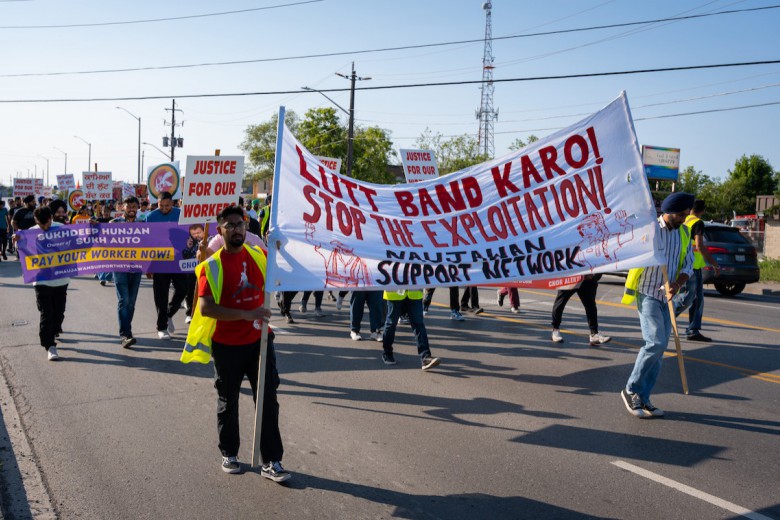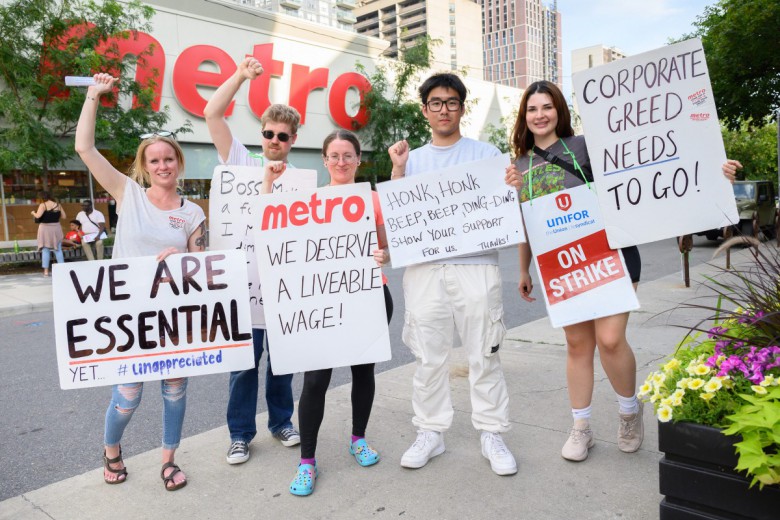Donnie MacLean worked at the same non-profit for nearly 13 years before mustering the nerve to quit. Moments after giving his notice, he overheard his bosses whisper, “he knows what’s going on here.”
In the months prior, some things about his workplace had started to bother MacLean: his bosses would charge exorbitant amounts for him and his co-workers to participate in company bonding activities; the pay was meagre and didn’t increase with experience; and all of the workers were disabled, but the managers weren’t.
MacLean didn’t know it at the time, but the organization he worked for, the Revolving Door, was a sheltered workshop – a segregated workplace for people labelled with intellectual and developmental disabilities. The workshops operate as “training programs” for disabled people to be skilled up to join the mainstream workforce, but the “training” label also means employers can evade employment standards.
“Despite not being called sheltered workshops anymore, unpaid and exploitative labour continues to thrive.”
For over a decade in the 1980s and ’90s, MacLean worked full-time hours at the Revolving Door, starting his days at 9 a.m. and ending around 4 or 5 p.m. For every 75 hours of work, he’d earn $30. But the Revolving Door also managed the bus that transported employees to and from work, a service for which they charged $9, shrinking MacLean’s twice-monthly paycheque to $21.
MacLean left the Revolving Door in the 1990s, but the business is still in operation today. They’ve rebranded as Carleton Road Industries Association and are one of 30 recognized sheltered workshops in Nova Scotia.
“Everyone knows what’s happening”
MacLean can’t remember exactly how he got into the sheltered workshop system – it’s a story educator Michael Baker has heard before. Baker teaches disabled high school students in Winnipeg, and through his job, he’s witnessed countless students be funnelled into sheltered workshops.
“Everyone knows what’s happening,” Baker says. He explains that in elementary school, children perceived as having learning difficulties are flagged for a psychological assessment and streamed into “modified and individualized programming,” as it’s called in Manitoba.
And if a disabled student does manage to land a job in the mainstream labour force after they graduate, their disability benefits are cut, a policy Baker says is punitive and coerces students into sheltered work.
Modified and individualized programming offers adjusted workloads, revised curriculums, access to an aide, and other accommodations. But it also means the student is in high school until the age of 21, and earns a “certificate of completion” instead of a high school diploma.
“They’re completely excluded from college and university and much of the workforce that requires a high school diploma,” Baker says. In addition, he says that many sheltered workshops canvas schools with disabled students, promoting their programs as providing work experience as well as a community that supports each other and does activities like swimming and bowling together. And if a disabled student does manage to land a job in the mainstream labour force after they graduate, their disability benefits are cut, a policy Baker says is punitive and coerces students into sheltered work.
Past and present-day sheltered work
Sheltered workshops date back to the 19th century in Canada. During the Industrial Revolution, workers were pushed to function like machines and produce at ever increasing speeds to maximize productivity and profit. This period not only enriched the upper class, but created a new class: disabled people whose bodies and minds didn’t adhere to the pace and norms of factory work and were deemed unemployable by factory owners. Shut out of the mainstream labour market and ineligible for workers’ compensation or other benefits, many disabled people were streamed into the liminal economy of sheltered work.
Today, sheltered workshops are called everything from “day programs” to “employment centres” to “activity centres.” In these workplaces, disabled people build wooden crates for 50 cents an hour; pack student exam care packages for a few pennies each; assemble windshield wiper tubes for a nickel a piece; and pin together Remembrance Day poppies for a penny a poppy.
Carleton Road calls itself an “adult services centre” that provides “community (supported) employment.” Like most sheltered workshops, Carleton Road is a non-profit organization and government grants make up the bulk of its revenue. Last year, it received a total of $717,988 in provincial and federal funding. They also reported $862,769 in revenue for the “sale of goods and services” which, according to their website, includes everything from woodworking to property maintenance to postal services. Importantly, Carleton Road has eight salaried employees to whom they pay real wages.
Shut out of the mainstream labour market and ineligible for workers’ compensation or other benefits, many disabled people were streamed into the liminal economy of sheltered work.
“Despite not being called sheltered workshops anymore, unpaid and exploitative labour continues to thrive,” disability studies scholar Dr. Jihan Abbas explains. She says that policy frameworks consider employment for disabled people to be a priority, which is why governments fund sheltered workshops instead of the supports disabled people need, like accessible and affordable housing, truly universal health care, and livable disability assistance payments.
What Abbas finds particularly interesting is how the companies which run sheltered workshops frame themselves as providing “corporate goodwill” because they are creating “employment opportunities” for disabled people. She points to ARC Industries, a self-described “non-profit business where people with a developmental handicap work as productive members of the Ottawa area community” that boasts that “paying your employees to perform these jobs is expensive” and “ARC industries offers the cost-effective, reliable alternative.”
By labelling the labour as “training” and “rehabilitation,” Abbas says companies have successfully avoided all oversight of their workplaces, making sheltered workshops difficult to track. There are no exact figures on the total number of sheltered workshops in Canada, but a 2008 study – the most recent study available – suggests that they’re in operation in every province and territory except Newfoundland.
In 2017, Kathleen Wynne’s Liberal government introduced a bill in Ontario to make it mandatory for employers to pay disabled people minimum wage, as an interim measure while the government worked toward closing all sheltered workshops in the province by 2019. But in 2018, Doug Ford’s Conservative government delayed the bill, and it still has no plan to end sheltered work. As of December 2017, 35 agencies were still operating sheltered workshops in Ontario.
The Ontario Ministry of Children, Community and Social Services told Briarpatch that Ontario no longer runs sheltered workshops and has completely moved to inclusive employment. But Briarpatch and the Disability Justice Network of Ontario have identified numerous sheltered workshops operating in province, including the Inclusion Coffeehouse in Hamilton; J.O.E. cafe in Guelph; the Owl Cafe in Ottawa; and the Ottawa-Carleton Association for Persons with Developmental Disabilities, which runs several sheltered workshops and has contracts with private companies as well as the federal government.
What Abbas finds particularly interesting is how the companies which run sheltered workshops frame themselves as providing “corporate goodwill” because they are creating “employment opportunities” for disabled people.
According to Baker, it’s rare that someone escapes sheltered work. “[It’s] not a goal of the program to graduate,” he says. Transitioning workers to the mainstream workforce would decrease sheltered workshops’ profitability, so despite being labelled “training programs,” almost half of workers stay in sheltered workshops for more than five years and over a fifth stay for more than 10 years.
“It’s a catch-22,” Baker argues. He explains that while sheltered workshops in large institutions are no longer the norm, the “gratuity pay” of the system traps workers in a cycle of poverty, leaving many with no choice but to live in institutions like group homes or long-term care facilities.
“That’s why transinstitutionalization is so insidious,” he explains. “It happens right there in front of you. It happens in the community [...] in plain sight. You don’t even notice it.”
In some cases, sheltered workshops are still housed within institutions for disabled people. Silver Spring Farm for one is a residence for people labelled with developmental disabilities who help keep the institution running by planting, braiding, and selling garlic on the farm for no wage.
Sheltered workshops and the labour movement
Since he left the Revolving Door, MacLean has worked in customer service and retail, alongside competing as a paralympic athlete. He also co-founded the Inclusive Opportunities Association to share and promote employment opportunities that pay fair wages to disabled workers. As opposed to sheltered workshops, which typically give disabled people whatever work companies can profit from, the association provides training so that disabled people can gain the skills they need to get their dream jobs. But he says that he still knows hundreds of disabled people trapped in the sheltered workshop system.
At the very least, MacLean wants to see sheltered workshops’ workers be paid the same wage as non-disabled workers. But he, Abbas, and Baker explain that remedying the system isn’t as simple as abolishing segregated work or paying people fair wages – it’s a larger systemic issue.
“[It’s] not a goal of the program to graduate."
“Our collective focus on work, making bodies productive, and seeing public policy as in service to private corporations all set the stage for this exploitative labour to thrive,” Abbas argues. While equal pay would provide significant material benefits to sheltered workshop workers, it doesn’t end their exploitation.
One thing Abbas does want to see is the labour movement standing in solidarity with disabled people. “There are some real tensions between union movements and disabled people,” she says. Unions often represent and fight on behalf of the staff of institutions that harm disabled people, like sheltered workshops, long-term care facilities, psychiatric hospitals, police forces, and prisons, with no concern for how their actions harm sheltered workshop workers, patients, and prisoners. In Abbas’ words: “The labour movement needs to be more inclusive and needs to take on this unpaid and [exploitative] labour in more vocal ways and in solidarity with disabled people.”
Thank you to Jaymee-Lynne Dowell, Megan Linton, Sarah Jama, and Róisín West for informing this article.







